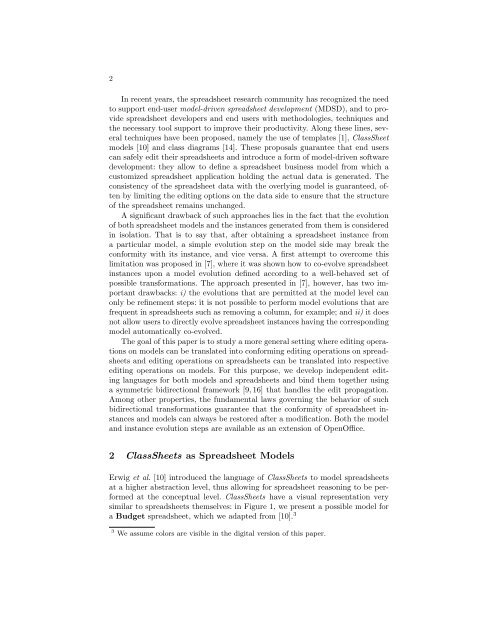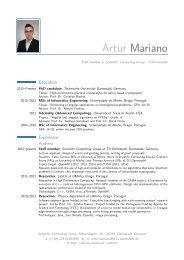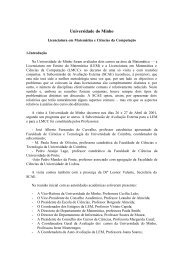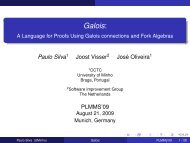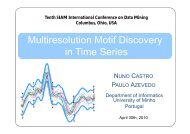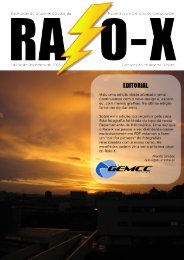Spreadsheet notoriously
Bidirectional Transformation of Model-Driven Spreadsheetsâ - ALFA
Bidirectional Transformation of Model-Driven Spreadsheetsâ - ALFA
- No tags were found...
Create successful ePaper yourself
Turn your PDF publications into a flip-book with our unique Google optimized e-Paper software.
2<br />
In recent years, the spreadsheet research community has recognized the need<br />
to support end-user model-driven spreadsheet development (MDSD), and to provide<br />
spreadsheet developers and end users with methodologies, techniques and<br />
the necessary tool support to improve their productivity. Along these lines, several<br />
techniques have been proposed, namely the use of templates [1], ClassSheet<br />
models [10] and class diagrams [14]. These proposals guarantee that end users<br />
can safely edit their spreadsheets and introduce a form of model-driven software<br />
development: they allow to define a spreadsheet business model from which a<br />
customized spreadsheet application holding the actual data is generated. The<br />
consistency of the spreadsheet data with the overlying model is guaranteed, often<br />
by limiting the editing options on the data side to ensure that the structure<br />
of the spreadsheet remains unchanged.<br />
A significant drawback of such approaches lies in the fact that the evolution<br />
of both spreadsheet models and the instances generated from them is considered<br />
in isolation. That is to say that, after obtaining a spreadsheet instance from<br />
a particular model, a simple evolution step on the model side may break the<br />
conformity with its instance, and vice versa. A first attempt to overcome this<br />
limitation was proposed in [7], where it was shown how to co-evolve spreadsheet<br />
instances upon a model evolution defined according to a well-behaved set of<br />
possible transformations. The approach presented in [7], however, has two important<br />
drawbacks: i) the evolutions that are permitted at the model level can<br />
only be refinement steps: it is not possible to perform model evolutions that are<br />
frequent in spreadsheets such as removing a column, for example; and ii) it does<br />
not allow users to directly evolve spreadsheet instances having the corresponding<br />
model automatically co-evolved.<br />
The goal of this paper is to study a more general setting where editing operations<br />
on models can be translated into conforming editing operations on spreadsheets<br />
and editing operations on spreadsheets can be translated into respective<br />
editing operations on models. For this purpose, we develop independent editing<br />
languages for both models and spreadsheets and bind them together using<br />
a symmetric bidirectional framework [9, 16] that handles the edit propagation.<br />
Among other properties, the fundamental laws governing the behavior of such<br />
bidirectional transformations guarantee that the conformity of spreadsheet instances<br />
and models can always be restored after a modification. Both the model<br />
and instance evolution steps are available as an extension of OpenOffice.<br />
2 ClassSheets as <strong>Spreadsheet</strong> Models<br />
Erwig et al. [10] introduced the language of ClassSheets to model spreadsheets<br />
at a higher abstraction level, thus allowing for spreadsheet reasoning to be performed<br />
at the conceptual level. ClassSheets have a visual representation very<br />
similar to spreadsheets themselves: in Figure 1, we present a possible model for<br />
a Budget spreadsheet, which we adapted from [10]. 3<br />
3 We assume colors are visible in the digital version of this paper.


